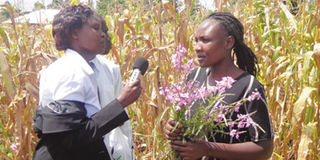Maize farmers bet on pilot weed removal plan to reap higher yields

PHOTO | RAPHAEL WANJALA Mrs Beatrice Okello (right) talks to officials of the ISMA project in Chakol. Her farm has been attacked by the striga weed.
What you need to know:
- Project in Western Kenya seeks to eradicate the choking and deadly striga weed that has affected grain production
Maize farmers in western Kenya are hoping to earn more from a multi-million shilling weed eradication programme.
The project dubbed Integrated Striga Management in Africa aims to kill the deadly weed from farms using various means.
Striga, also known as witch weed, is parasitic and attacks cereals such as maize, sorghum, millet, and legumes, decimating production.
The project targets Bondo, Vihiga, Siaya, Rachuonyo, Homa Bay, and Busia districts and other striga-infested areas. It involves developing weed- resistant crops and practising farming methods that help reduce the effects of the weed.
The initiative is funded by the US-based Bill and Melinda Gates Foundation.
The project manager, Dr Mel Oluoch, said the weed is a major hindrance to crop production for small-scale farmers in sub-Saharan Africa.
He said the project seeks to introduce new varieties of seeds that are coated with a herbicide formula that kills the weed. The herbicide then forms a protection zone around the roots of the plant.
“This variety will release the herbicide into the soil at different stages during growth and suffocate the weed to allow the crop to flourish,” he said.
Dr Oluoch said the new technology has been fully commercialised by seed companies in the country. “The weed is so dangerous that by the time farmers notice it in their farms, it is already too late and the effects are deadly,” he said. Dr Oluoch said poor disposal of the weed could also be a factor in its spread as farmers uproot and throw it casually, leading it to be spread by runoff water. The weed has massive seed production that if not contained could stay in the soil for about 15 years.
“A single plant can produce about 50,000 seeds and if not contained, can multiply to new plants,” said Dr Oluoch.
Mrs Beatrice Okello, 27, a farmer in Chakol, Teso South District, said the weed has affected her maize crop over the past five years. “I have tried to eradicate it unsuccessfully. I used to plant five acres of maize but after the weed attacked the crop, I only plant one acre and place the rest under beans, which are not affected,” said Mrs Okello.
She said ordinarily, she would harvest a minimum of 10 bags from an acre but this has been greatly reduced.
Mr Robert Owaya, another farmer, said most of the maize crop has been affected by striga and hoped that the new technology could help curb it.
Dr Oluoch said a more affordable option was the use of indigenous fungi that are enemies of the weed. He said the fungi is introduced into the soil and attacks the weed at all growth stages. The project seeks to increase maize yield in sub-Saharan Africa by about 40 per cent during the first phase of the four-year project and 600 per cent in the second phase.
Research shows that global warming has been a factor in the spread of the weed in sub-Saharan Africa.
A research scientist at the International Centre of Insect Physiology and Ecology (ICIPE), Mr Jimmy Picha, said climate change had accelerated the spread of the weed in areas that had not been previously affected. He said the weed manifests in areas with high soil temperature and that the recent changes in weather patterns has seen it spread faster.



